Empire Service
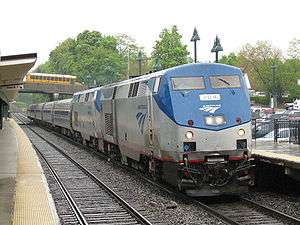 Empire Service train #235 entering Poughkeepsie station in May 2008 | |||||||||||||||||||||||||||||||||||||||||||||||||||||||||||||||||||||||||||||||||||||||||||||||||||||||||||||||||||||||||||||||||||||||||||||||||||||||||||||||||||||||||||||||||||||||||||||||||||||||||||||||||||||||||||||||||||||||||||||||||||||||
| Overview | |||||||||||||||||||||||||||||||||||||||||||||||||||||||||||||||||||||||||||||||||||||||||||||||||||||||||||||||||||||||||||||||||||||||||||||||||||||||||||||||||||||||||||||||||||||||||||||||||||||||||||||||||||||||||||||||||||||||||||||||||||||||
|---|---|---|---|---|---|---|---|---|---|---|---|---|---|---|---|---|---|---|---|---|---|---|---|---|---|---|---|---|---|---|---|---|---|---|---|---|---|---|---|---|---|---|---|---|---|---|---|---|---|---|---|---|---|---|---|---|---|---|---|---|---|---|---|---|---|---|---|---|---|---|---|---|---|---|---|---|---|---|---|---|---|---|---|---|---|---|---|---|---|---|---|---|---|---|---|---|---|---|---|---|---|---|---|---|---|---|---|---|---|---|---|---|---|---|---|---|---|---|---|---|---|---|---|---|---|---|---|---|---|---|---|---|---|---|---|---|---|---|---|---|---|---|---|---|---|---|---|---|---|---|---|---|---|---|---|---|---|---|---|---|---|---|---|---|---|---|---|---|---|---|---|---|---|---|---|---|---|---|---|---|---|---|---|---|---|---|---|---|---|---|---|---|---|---|---|---|---|---|---|---|---|---|---|---|---|---|---|---|---|---|---|---|---|---|---|---|---|---|---|---|---|---|---|---|---|---|---|---|---|---|---|---|---|---|---|---|---|---|---|---|---|---|---|---|---|---|---|
| Service type | Inter-city rail, higher speed rail | ||||||||||||||||||||||||||||||||||||||||||||||||||||||||||||||||||||||||||||||||||||||||||||||||||||||||||||||||||||||||||||||||||||||||||||||||||||||||||||||||||||||||||||||||||||||||||||||||||||||||||||||||||||||||||||||||||||||||||||||||||||||
| Status | Operating | ||||||||||||||||||||||||||||||||||||||||||||||||||||||||||||||||||||||||||||||||||||||||||||||||||||||||||||||||||||||||||||||||||||||||||||||||||||||||||||||||||||||||||||||||||||||||||||||||||||||||||||||||||||||||||||||||||||||||||||||||||||||
| Locale | New York | ||||||||||||||||||||||||||||||||||||||||||||||||||||||||||||||||||||||||||||||||||||||||||||||||||||||||||||||||||||||||||||||||||||||||||||||||||||||||||||||||||||||||||||||||||||||||||||||||||||||||||||||||||||||||||||||||||||||||||||||||||||||
| First service | December 3, 1967 | ||||||||||||||||||||||||||||||||||||||||||||||||||||||||||||||||||||||||||||||||||||||||||||||||||||||||||||||||||||||||||||||||||||||||||||||||||||||||||||||||||||||||||||||||||||||||||||||||||||||||||||||||||||||||||||||||||||||||||||||||||||||
| Current operator(s) | Amtrak | ||||||||||||||||||||||||||||||||||||||||||||||||||||||||||||||||||||||||||||||||||||||||||||||||||||||||||||||||||||||||||||||||||||||||||||||||||||||||||||||||||||||||||||||||||||||||||||||||||||||||||||||||||||||||||||||||||||||||||||||||||||||
| Former operator(s) | |||||||||||||||||||||||||||||||||||||||||||||||||||||||||||||||||||||||||||||||||||||||||||||||||||||||||||||||||||||||||||||||||||||||||||||||||||||||||||||||||||||||||||||||||||||||||||||||||||||||||||||||||||||||||||||||||||||||||||||||||||||||
| Ridership |
1,152,536 (New York-Albany FY15) 403,985 (Albany-Toronto FY15)[1] | ||||||||||||||||||||||||||||||||||||||||||||||||||||||||||||||||||||||||||||||||||||||||||||||||||||||||||||||||||||||||||||||||||||||||||||||||||||||||||||||||||||||||||||||||||||||||||||||||||||||||||||||||||||||||||||||||||||||||||||||||||||||
| Route | |||||||||||||||||||||||||||||||||||||||||||||||||||||||||||||||||||||||||||||||||||||||||||||||||||||||||||||||||||||||||||||||||||||||||||||||||||||||||||||||||||||||||||||||||||||||||||||||||||||||||||||||||||||||||||||||||||||||||||||||||||||||
| Start | New York Penn Station, New York City and Grand Central Terminal, New York City (limited trains) | ||||||||||||||||||||||||||||||||||||||||||||||||||||||||||||||||||||||||||||||||||||||||||||||||||||||||||||||||||||||||||||||||||||||||||||||||||||||||||||||||||||||||||||||||||||||||||||||||||||||||||||||||||||||||||||||||||||||||||||||||||||||
| End | Niagara Falls Station and Customhouse Interpretive Center, Niagara Falls, NY | ||||||||||||||||||||||||||||||||||||||||||||||||||||||||||||||||||||||||||||||||||||||||||||||||||||||||||||||||||||||||||||||||||||||||||||||||||||||||||||||||||||||||||||||||||||||||||||||||||||||||||||||||||||||||||||||||||||||||||||||||||||||
| Distance travelled | 460 miles (740 km) | ||||||||||||||||||||||||||||||||||||||||||||||||||||||||||||||||||||||||||||||||||||||||||||||||||||||||||||||||||||||||||||||||||||||||||||||||||||||||||||||||||||||||||||||||||||||||||||||||||||||||||||||||||||||||||||||||||||||||||||||||||||||
| On-board services | |||||||||||||||||||||||||||||||||||||||||||||||||||||||||||||||||||||||||||||||||||||||||||||||||||||||||||||||||||||||||||||||||||||||||||||||||||||||||||||||||||||||||||||||||||||||||||||||||||||||||||||||||||||||||||||||||||||||||||||||||||||||
| Class(es) | Business class and reserved coach | ||||||||||||||||||||||||||||||||||||||||||||||||||||||||||||||||||||||||||||||||||||||||||||||||||||||||||||||||||||||||||||||||||||||||||||||||||||||||||||||||||||||||||||||||||||||||||||||||||||||||||||||||||||||||||||||||||||||||||||||||||||||
| Catering facilities | On-board cafe | ||||||||||||||||||||||||||||||||||||||||||||||||||||||||||||||||||||||||||||||||||||||||||||||||||||||||||||||||||||||||||||||||||||||||||||||||||||||||||||||||||||||||||||||||||||||||||||||||||||||||||||||||||||||||||||||||||||||||||||||||||||||
| Technical | |||||||||||||||||||||||||||||||||||||||||||||||||||||||||||||||||||||||||||||||||||||||||||||||||||||||||||||||||||||||||||||||||||||||||||||||||||||||||||||||||||||||||||||||||||||||||||||||||||||||||||||||||||||||||||||||||||||||||||||||||||||||
| Rolling stock | Amfleet coaches | ||||||||||||||||||||||||||||||||||||||||||||||||||||||||||||||||||||||||||||||||||||||||||||||||||||||||||||||||||||||||||||||||||||||||||||||||||||||||||||||||||||||||||||||||||||||||||||||||||||||||||||||||||||||||||||||||||||||||||||||||||||||
| Track gauge | 4 ft 8 1⁄2 in (1,435 mm) | ||||||||||||||||||||||||||||||||||||||||||||||||||||||||||||||||||||||||||||||||||||||||||||||||||||||||||||||||||||||||||||||||||||||||||||||||||||||||||||||||||||||||||||||||||||||||||||||||||||||||||||||||||||||||||||||||||||||||||||||||||||||
| Operating speed | Up to 110 mph (177 km/h) | ||||||||||||||||||||||||||||||||||||||||||||||||||||||||||||||||||||||||||||||||||||||||||||||||||||||||||||||||||||||||||||||||||||||||||||||||||||||||||||||||||||||||||||||||||||||||||||||||||||||||||||||||||||||||||||||||||||||||||||||||||||||
| Track owner(s) | MNRR, Amtrak, CSXT | ||||||||||||||||||||||||||||||||||||||||||||||||||||||||||||||||||||||||||||||||||||||||||||||||||||||||||||||||||||||||||||||||||||||||||||||||||||||||||||||||||||||||||||||||||||||||||||||||||||||||||||||||||||||||||||||||||||||||||||||||||||||
| |||||||||||||||||||||||||||||||||||||||||||||||||||||||||||||||||||||||||||||||||||||||||||||||||||||||||||||||||||||||||||||||||||||||||||||||||||||||||||||||||||||||||||||||||||||||||||||||||||||||||||||||||||||||||||||||||||||||||||||||||||||||
The Empire Service is a higher-speed train service operated by Amtrak within the state of New York in the United States. The brand name originated with the New York Central Railroad in 1967. Trains on the line provide frequent daily service along the 460-mile (740 km) Empire Corridor between New York City and Niagara Falls, New York via Albany, the state capital.
During fiscal year 2014, the Empire Service carried 1,119,959 passengers on the line between New York and Albany, while services between Albany and points west, including the Maple Leaf and Lake Shore Limited, carried an additional 410,344.[1] Ridership on the first section of the Empire Service's line increased from FY2013 by 5.2%.[1] Ticket revenue on the New York-Albany section was US$47,472,663, while revenue on the Albany-Toronto route was $24,712,104.[1]
Services
Hourly weekday service is available on the Hudson portion of the line between New York Penn Station and Albany–Rensselaer. The Upstate portion west of Albany is served by a total of four trains in each direction daily:
- Two Empire Service trains continuing to Niagara Falls (formerly known as the Water Level Route)
- The daily Maple Leaf to Niagara Falls before continuing to Toronto
- The Lake Shore Limited which follows the Empire Corridor as far as Buffalo–Depew en route to Chicago.
The Adirondack to Montreal and Ethan Allen Express to Rutland, Vermont also supplement service on the southern portion of the line between New York and Albany.
The portion of the route south of Poughkeepsie is the Metro-North Railroad's Hudson Line, and sees frequent commuter service.
The Empire Service is one of four New York State-based train routes that Amtrak operates with funding from the New York State Department of Transportation with the other three routes being the Adirondack, the Maple Leaf, and the Ethan Allen Express.
History
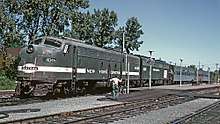
The route was formerly the Water Level Route of the New York Central Railroad to Buffalo and then the former Buffalo and Niagara Falls Railroad. In December 1967, just months before its merger with the Pennsylvania Railroad to become the Penn Central Transportation Company, the Central reorganized all its passenger trains. Gone were individual train names. In their place the Central introduced the Empire Service brand for New York–Buffalo trains. Marketing emphasized convenient service within New York, with a reduced emphasis on long-distance trains which continued west of Buffalo. This program continued after the Penn Central merger.[2] The new scheduling produced mixed results; passengers were deterred by the poor quality of the passenger cars and the inconvenient locations of stations along the route.[3]
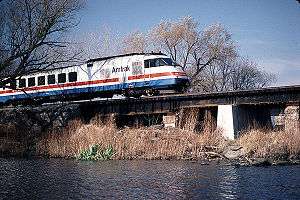
Amtrak began on May 1, 1971, with seven daily trains on the New York—Albany—Buffalo corridor: four operated New York—Albany and three ran through to Buffalo. All service west of Buffalo was discontinued. All the trains retained their ex-Penn Central numbers and were otherwise nameless.[4] Westward service resumed briefly after May with the introduction of the Chicago–New York Lake Shore, but this train was canceled on January 6, 1972.
Despite doubts about Amtrak's potential success, the company was key in reestablishing some discontinued services along the Empire Corridor. Service beyond Buffalo to Niagara Falls, which had been abandoned by the New York Central in 1961, was reestablished with such trains as the Niagara Rainbow and the Maple Leaf. In addition Amtrak restored service to downtown Schenectady in 1978, a service which Penn Central had discontinued in 1968, for all Empire Service trains that continued beyond Albany. Service was restored permanently on the New York Central Water Level Route to Chicago with the reintroduction of the old New York Central train, the Lake Shore Limited in 1975.
On April 7, 1991, all Amtrak Empire Service trains started using the new Empire Connection into Penn Station, New York. Prior to that change, all passenger trains from Albany and beyond went into Grand Central Terminal which forced passengers going beyond New York to transfer via shuttle bus, taxicab, or via the New York City Subway to reach Penn Station. The move also saved Amtrak the expense of operating two stations in New York.
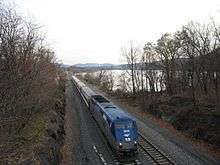
In October 2011, CSX and Amtrak reached an agreement for Amtrak to lease the Hudson Subdivision between Poughkeepsie and Schenectady, with Amtrak assuming maintenance and capital responsibilities. CSX will retain freight rights over the line, which hosts only five freights a day. Amtrak will use federal funds to double track the line between Rensselaer and Schenectady, and add an additional station track at the Albany–Rensselaer station. Amtrak sees the lease as key to improving Empire Service speeds and frequencies.[5] Amtrak officially assumed control on December 1, 2012, with trains in the section now dispatched by the Amtrak Control and Command Center in New York City.[6]
In June 2017, Amtrak announced that from July 10 through September 1, six Empire Service trains (three round trips) would arrive and depart from Grand Central Terminal as part of Amtrak's work to make repairs at Penn Station. [7]
On April 10, 2018, Amtrak announced once again that all trains using the Empire Connection, excluding the Lake Shore Limited, will operate into Grand Central Terminal from May 26, to September 4, 2018 to allow work on the Empire Tunnel, the Spuyten Duyvil movable bridge, and Track 19 in New York's Penn Station.[8] The Empire Connection includes all three key infrastructure pieces above, allowing operation into Penn Station from the Empire Corridor, so there is no feasible way to get between these places while work is being done. The renewal work includes replacing track and cross ties in the Empire Tunnel, placing 8,000 feet (2,400 m) of continuous rail, updating grade crossings between the tunnel and the Spuyten Duyvil Bridge, updating the bridge’s mechanical and electrical equipment (which was heavily damaged by Hurricane Sandy), and replacing ballast, wooden ties, and three turnouts at Track 19 in Penn Station.[8]
Route details
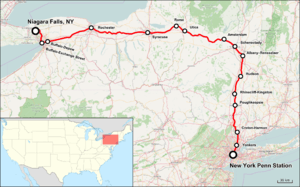
The Empire Service operates over CSX Transportation, Metro-North Railroad, and Amtrak trackage:
- CSX Niagara Subdivision, Buffalo Terminal Subdivision, Rochester Subdivision, Mohawk Subdivision, Selkirk Subdivision, and Hudson Subdivision, Niagara Falls to Poughkeepsie (Amtrak-owned between Hoffmans and Schenectady)
- Metro-North Railroad Hudson Line, Poughkeepsie to Spuyten Duyvil
- Amtrak Empire Connection, Spuyten Duyvil to Penn Station
The Empire Service utilizes dual-mode locomotives due to a ban on diesel locomotive operations in the Penn Station tunnel. An "on the fly" power change from diesel to third rail (or vice versa) takes place once the train enters the tunnel near Penn Station.
Equipment
.jpg)
The New York Central did not order new equipment for the Empire Service, preferring to rehabilitate existing equipment. 40 64-seat coaches, built by Pullman-Standard in 1946, were refurbished in 1967–1968. Another 21 coaches from the same pool were rebuilt as 50-seat "coach-buffet" cars.[9] Amtrak acquired this equipment when it took over the Penn Central's passenger trains in 1971.[10] The cars remained on the Empire Service under Amtrak into the mid-1970s. A typical train between New York and Albany consisted of two coaches and the coach-buffet or "snack bar" coach. Trains which operated west of Albany had additional coaches.[11]. Presently, the Empire Service usually operates with a single GE P32AC-DM locomotive, four Amfleet coaches, and a split café/Business class car.[12]
Station stops
High-speed rail
The Empire Service has been a long-standing candidate for high-speed rail and electrification. The need for high-speed rail service has been addressed by former Governor George Pataki, former Senate Majority Leader Joseph Bruno, and members of the New York State Assembly who represent the upstate regions. Other politicians have asked that high-speed rail be introduced along the Empire Corridor, diminishing the time for New York City – Buffalo trains from seven hours to just three hours; train travel from New York City to Albany would take less than two hours to complete. This may introduce Acela trains to the Empire Corridor if high-speed rail is successful. Another reason, which politicians have noted, is that high-speed trains might help improve upstate New York's economy, which had become stagnant.
Currently, trains attain a maximum speed of 110 mph (177 km/h) on the stretch of track just south and west Albany. Areas east of Schenectady also see speeds above 79 mph (127 km/h).
Notes
- 1 2 3 4 "Amtrak Ridership and Revenues Continue Strong Growth in FY 2014" (PDF). Amtrak. October 27, 2014. Retrieved April 8, 2018.
- ↑ "They're brightening up the Empire Trains" (PDF). Penn Central Post. April 15, 1968.
- ↑ Saunders 2001, p. 377
- ↑ Amtrak (May 1, 1971). "Nationwide Schedules of Intercity Passenger Service". Archived from the original on September 8, 2013. Retrieved September 6, 2013.
- ↑ Eric Anderson (October 18, 2011). "Amtrak leasing track corridor". Times-Union. Retrieved October 25, 2011.
- ↑ "Governor Cuomo Announces Hudson Rail Line Lease" (Press release). Albany, NY: Office of Governor Andrew M. Cuomo. December 4, 2012.
- ↑ "Select Empire Service Trains to Operate to/from Grand Central Terminal during Infrastructure Renewal Period" (Press release). Amtrak. July 3, 2017.
- 1 2 "Amtrak Announces Summer Infrastructure Renewal Work" (Press release). Amtrak. April 10, 2018.
- ↑ Wayner 1972, pp. 34; 37
- ↑ Simon & Warner 2011, pp. 135; 150–151
- ↑ Wayner 1977, pp. 18–19
- ↑ "Empire Service". TrainWeb. Retrieved April 8, 2018.
References
- Saunders, Richard (2001) [1978]. Merging Lines: American Railroads 1900–1970 (Revised ed.). DeKalb, Illinois: Northern Illinois University Press. ISBN 978-0-87580-265-7.
- Simon, Elbert; Warner, David C. (2011). Amtrak by the numbers: a comprehensive passenger car and motive power roster, 1971-2011. Kansas City, Missouri: White River Productions. ISBN 978-1-932804-12-6.
- Wayner, Robert J., ed. (1972). Car Names, Numbers and Consists. New York: Wayner Publications. OCLC 8848690.
- Amtrak Consists (2nd ed.). New York, NY: Wayner Publications. 1977. OCLC 4279671.
External links
| Wikimedia Commons has media related to Empire Service. |